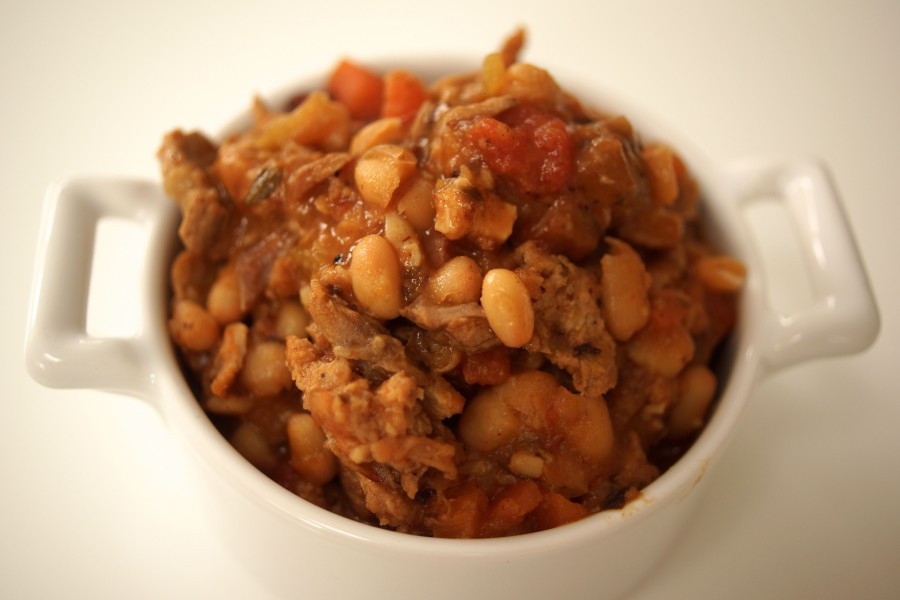Classic Cassoulet

(serves 8)
for the confit:
1/2 cup/120ml olive oil
1/2 cup/100g duck fat
4 duck legs
coarse sea salt
4 fat garlic cloves, finely chopped
4 bay leaves, broken in half
2 cups/570ml white wine
for the cassoulet:
4 Toulouse sausages, ready-made or make your own
350g/12oz belly pork, skinned and diced (slab bacon, or ordinary bacon if you must)
350g/12oz lamb neck fillet, shoulder or rolled breast, diced
1 large onion, chopped roughly
2 large carrots, chopped roughly
2 celery sticks, chopped roughly
400g/14oz can chopped tomatoes
1 tbsp tomato purée
2 heaped tbsp fresh flat leaf parsley, chopped
1 heaped tbsp fresh thyme, chopped
sea salt and pepper
290ml/½ pint dry white wine
3 soup cans haricot or cannellini beans, drained and rinsed
3 1/2 cups/850ml chicken stock, with more to add later if needed
for the topping:
1 large day-old baguette (or 1 cup fresh homemade breadcrumbs)
2 fat garlic cloves, halved
4 tbsp butter
2 heaped tbsp fresh flat leaf parsley, chopped
1 heaped tbsp fresh thyme, chopped
In a large frying pan big enough to accommodate the duck, and which has a lid, heat the duck fat until melted. Place the duck legs skin side down in the frying pan, sprinkle with the salt, garlic and bay leaves and pour the white wine around. Place the lid on top and cook at the tiniest simmer possible, for two hours. Of course, for real confit you’d pour the winey fat over the duck in a sealed container and preserve it, but no need for that step here, as you’ll be using the duck straightaway.
Meanwhile, place the sausages in a 220C/425F oven and bake for 20 minutes. Set aside to cool.
In a large stovetop- and ovenproof dish that will hold all the ingredients, place the belly pork and heat gently until fat begins to be released, then raise heat and cook, stirring occasionally, until all the fat has been released and the pork is crisp, but not dry. Lift the pork onto a plate with a slotted spoon, leaving all the fat behind.
Add the lamb to the pork fat and cook until colored on all sides, then lift out with slotted spoon and set aside with the pork.
Add the diced vegetables to the pork fat and cook till soft. Tip the ingredients from the plate back into the dish. Add the tomatoes, tomato purée and herbs, then season with sea salt and pepper to taste.
Add the wine, haricot beans and chicken stock to the dish and bring to the boil. Stir, then lower the heat so the liquid is just simmering. Keep the mixture in the same dish to cook or transfer it to an earthenware dish.
When the duck has cooked for two hours, remove it from the duck-fat/wine and cool to handle. Remove the skin from the duck, then tuck the duck legs into the cassoulet. Set aside the duck-fat/wine mixture.
Peel off the sausage skins, slice the sausagemeat thickly on the diagonal and tuck into the dish.
Cover the dish and bake for 1 hour, stirring once. Stir, then cook uncovered for a further 1–1½ hours, stirring halfway, until the meat is really tender and the sauce is thickened. Take the dish out of the oven and remove the duck legs. Strip the meat from the bones (it will fall off easily) and return the meat to the dish. Stir and add a little stock and some of the duck-fat/wine, if necessary. Season if necessary, then return to the oven and bake for another 15 minutes until all the meat and beans are very tender. At this point the cassoulet can be refrigerated for up to two days, then reheated to serve.
For the topping, cut the crusts off the baguette, tear the bread into pieces and put in a food processor. Add the garlic and chop into coarse crumbs (you should have about a cup of garlicky bread crumbs).
Heat the butter in a large frying pan until sizzling, then stir fry the breadcrumbs and garlic over a moderate to high heat for 7–8 minutes until crisp and golden. Remove from the heat, toss in the herbs and stir to mix, then season well with salt and pepper.
Ladle the cassoulet in generous servings into warm bowls, sprinkle on a bit of topping, and serve.

